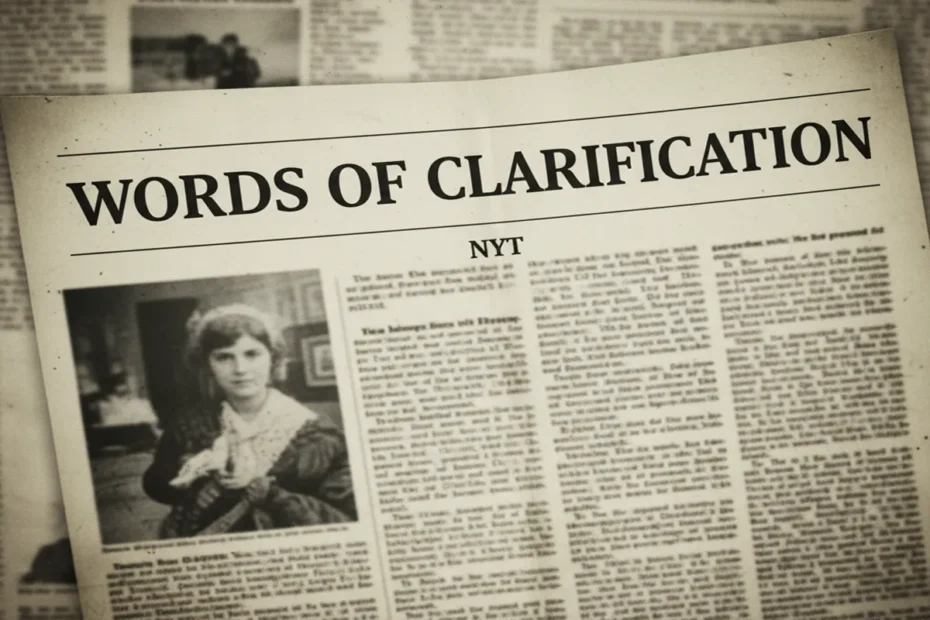The New York Times crossword has long been known for its clever wordplay, subtle hints, and mind-twisting clues that challenge solvers to think creatively. One phrase that often sparks curiosity among crossword enthusiasts is “words of clarification NYT.” At first glance, it may seem simple, but like many NYT crossword clues, there’s usually more depth beneath the surface. Understanding what this clue means and how to approach it can make all the difference in solving puzzles with confidence.
What Does “Words of Clarification NYT” Mean?
When the clue “words of clarification NYT” appears in a crossword puzzle, it typically refers to short phrases used to make something clearer in conversation or writing. These could include expressions like “that is,” “in other words,” or “to clarify.” Such phrases signal that the speaker or writer is about to explain something more simply or directly.
In crossword puzzles, these clues are often indirect, requiring solvers to think not just about the definition but also about the function of the phrase. The New York Times crossword often uses linguistic cues and logical twists, so understanding context is crucial.
For instance, a clue like “Words of clarification” might have an answer such as “I MEAN,” “THAT IS,” or “TO WIT.” Each of these phrases serves to clarify or restate information, perfectly aligning with the clue’s intention.
Why the Phrase Appears Frequently in NYT Crosswords
The popularity of “words of clarification NYT” stems from the puzzle’s reliance on everyday speech patterns. Crossword creators love to use conversational language because it connects with solvers on a human level. Phrases like “I mean” or “that is” appear often in daily dialogue, making them accessible yet tricky enough when disguised in crossword form.
Furthermore, The New York Times crossword thrives on balance, mixing common knowledge with challenging clues. “Words of clarification” fall into that sweet spot: not overly obscure, but still requiring thoughtful interpretation.
Common Answers for “Words of Clarification NYT”
While crossword puzzles constantly evolve, some classic answers have stood the test of time. Here are a few examples of entries frequently associated with the clue “words of clarification NYT”:
-
I MEAN: A conversational phrase used to restate something.
-
THAT IS: Often abbreviated as “i.e.,” in writing, it serves to explain or clarify.
-
TO WIT: A more formal or old-fashioned expression meaning “namely” or “that is to say.”
-
IN OTHER WORDS: A longer phrase but occasionally shortened in crosswords for variety.
The right answer always depends on the number of letters specified in the puzzle and how it fits with the intersecting clues.
The Linguistic Importance of Clarifying Words
From a linguistic perspective, words of clarification are essential tools in communication. They ensure understanding, prevent misinterpretation, and strengthen the coherence of dialogue. In journalism and literature—including publications like The New York Times clarifying expressions allow writers to refine their points, making complex information more accessible to readers.
When seen through this lens, the clue “words of clarification NYT” reflects not only the playfulness of crossword puzzles but also the precision of language itself. It highlights how small expressions can carry great weight in shaping meaning.
How to Solve Clues Like “Words of Clarification NYT”
Solving crossword clues that use language-based hints requires both logic and intuition. Here are a few strategies to approach such clues effectively:
-
Look for Context: If the clue includes quotation marks or conversational hints, think about dialogue phrases.
-
Count the Letters: The length of the answer is your best guide narrowing down potential options.
-
Cross-Reference with Other Clues: Use confirmed letters from neighboring answers to eliminate wrong guesses.
-
Consider Tone: “Words of clarification” usually suggest informal or explanatory speech, not technical jargon.
These tips can help you decode the clue “words of clarification NYT” and many others like it with greater accuracy.
Why Crossword Fans Love Language-Based Clues
Language-driven clues like “words of clarification NYT” are beloved because they blend wit, logic, and linguistic insight. They remind solvers that English isn’t just a set of rules, it’s a living, breathing system full of nuances. The joy of solving such clues lies in that “aha!” moment when the answer suddenly makes perfect sense.
Moreover, for avid crossword fans, these clues reinforce the bond between words and meaning. Each solution deepens the appreciation for language and its endless creativity.
Final Thoughts
The phrase “words of clarification NYT” embodies what makes the New York Times crossword so enduring and intellectually rewarding. It encourages solvers to think carefully about how words function in communication how we explain, clarify, and connect through language. Whether the answer is “I MEAN,” “THAT IS,” or “TO WIT,” it’s a small but meaningful reminder of the beauty of expression.
So the next time you come across “words of clarification NYT” in your puzzle, take a moment to appreciate not just the challenge, but the art behind the clue. After all, every great crossword isn’t just about finding the right words; it’s about discovering how words bring clarity to thought.
FAQs
1. What does “words of clarification NYT” mean?
The phrase “words of clarification NYT” refers to crossword clues that hint at phrases used to explain or restate something, such as “I MEAN” or “THAT IS.”
2. What are common answers for the “words of clarification NYT” clue?
Typical answers include “I MEAN,” “THAT IS,” “TO WIT,” and sometimes “IN OTHER WORDS,” depending on the puzzle’s length and context.
3. Why does The New York Times crossword use clues like “words of clarification”?
These clues test solvers’ understanding of conversational English and encourage thinking beyond definitions, focusing on how language clarifies ideas.
4. How can I solve clues like “words of clarification NYT” more easily?
Look at the letter count, check intersecting answers, and think of short phrases people use to explain or rephrase something in daily conversation.
5. Are “words of clarification” clues difficult to solve?
They’re moderately challenging, perfect for solvers who enjoy language-based puzzles that blend everyday speech with clever wordplay.
